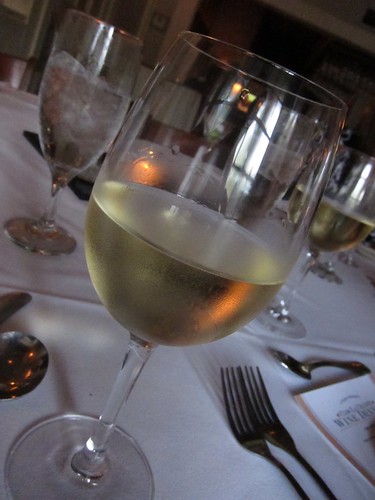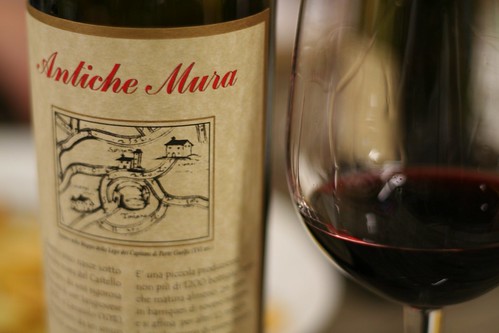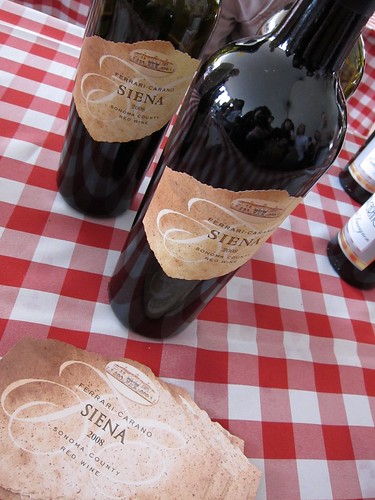Many of you may have noticed that we at Dining In Austin don't rate only food and restaurants. From time to time we also rate wines. If I have a particularly good or bad glass of wine with a meal then I feel it's my duty to tell you about it. When I was in my early 20's though (yeah that's going to date me), I used to drink wine with a rather binary approach, either I liked it or I didn't. When I started to write about food a few years ago, I decided to take a few wine tasting classes so I could talk the talk and walk the walk when it came to wine. This, my fine foodie friends, is my organized, engineer-like breakdown of how to taste wine based on the notes I've taken from 10 or so different wine tasting classes.
Appearance
1) Tilt the wine glass to a 30 degree angle. Inspect the color and clarity. If its murky or cloudy, then say so, also note if its a thin or a vibrant color. Now don't just say "It's a red wine", snooty wine drinkers don't like it when you state the obvious. Say "It's a rich garnet red color" or "It's a light raspberry red color". If its a white wine, see if there's a tint of a secondary color. Say "This white wine has a reddish tinge"? You have to add a descriptive word or two to the obvious color of the wine. It's like identifying colors in kindergarten, only with alcohol. It's fun!

Ultimately you want to get good enough to say "This white wine has a vibrant straw color with a hint of red". Wine drinkers love that, that'll get you in the door.
Some wine drinkers will tell you to swirl the wine and look at the "legs", the drip lines to see how sugary/alcoholic a wine is. Basically, the thicker and more syrupy the legs are, the higher the sugar/alcohol content is. However, I've never really seen any use to this. A taste test tells me so much more about the sugar and alcohol balance of a wine than the legs. But, a lot of snooty wine drinkers do this, so if you're in a group of them, feel free to comment on the legs.
Aroma
This is my favorite part of wine tasting (aside from the actual drinking). You can know absolutely nothing about wine but look like a Master Sommelier with a few simple tricks.
1) Swirl the wine, this is very important, it agitates the wine and releases the aromas, plus it looks cool
2) Smelling for Fruits: Stick your nose way, way, way down into the glass and smell. This is where you'll smell the fruit aromas. All wines will generally have one fruit smell thats pronounced and a couple of secondary fruit smells. Most of the time when you smell a wine you can pick up the aroma of at least one fruit, but if you can't, who cares! Pick a couple of fruits off the list below and throw them out there. No one will know. Trust me.
White Wine Fruits - lemons, limes, green apples, apricots, pears
Red Wine Fruits - cherry, blackberry, raspberry, strawberry, currants
3) Smelling for Plants: Stick your nose just inside the bottom rim of the glass (the side of the rim closest to you) and smell. This is where you'll smell the floral bouquet of the wine. Not all wines will have a distinct floral smell, but a lot of them will. Some wines will also have a vegetal smell. Whites might smell green peppery or grassy while reds might smell of camphor or eucalyptus.
White Wine Plants - orange blossom, honeysuckle, grass
Red Wine Plants - lavender, rose, violet, lilac, camphor
4) Smelling for Minerals and Spices: Stick your nose just inside the top tom of the glass (the side of the rim farthest from you) and smell. This is where you'll smell the minerals of a white wine and the spices of a red wine.
White Wine Minerals - seaspray, chalky, flinty, toast, straw, butter, nutty
Red Wine Spices - chocolate, leather, tobacco/smoke, licorice, vanilla, pepper, butterscotch
5) Smelling for Overtones: Stick your nose over the rim and wave the glass back and forth under it. This is where you'll smell the overtones or chemical notes of a wine. Now, just because you might smell something odd in an overtone doesn't mean that its in the wine. Sometimes a really odd overtone makes the wine seem special or different. But trust me, now that you know to look for them, you'll notice some weird ones.
Wine Overtones - burning rubber, cat pee, gunpowder, sulphur, barnyard, tar

Here's the best part about smelling wine. Everyone smells something different. And 9 times out of 10 if you throw out something you think you smell in the wine, someone at the table will agree with you. The power of suggestion will work to your advantage in wine tasting.
Taste
The actual tasting of wine is highly overrated at an snooty wine tasting. 80% of wine "tasting" is smelling and wine snobs will spend a lot more time analyzing the smells of the wine than the tastes. But, you spend 90% of your time drinking a wine and not analyzing it, so enjoy it.
Now wine drinkers have a special way they drink wine when they're analyzing it. They call it "aspiration" and it looks incredibly silly and pretentious, but it does kind of work. Basically you take a sip of wine (but don't swallow), purse your lips like you're about to kiss your mom, stick your tongue between your teeth and suck in some air. It makes the wine bubble on your tongue and brings out the flavors of the wine. I generally don't do this when I sample wine, I mean, a girl's gotta have her dignity. But snotty wine drinkers do it, so I feel like I have to give you fair warning.

The qualities you analyze when you actually taste the wine fall into two categories: judging the body, and judging the flavors. Steps 1 through 4, below, will help you judge the body. Step 5 will help you judge the flavors.
1) Tasting for Acidity: Basically, this is a binary choice. Does the wine have crisp or zingy quality, indicating a higher acidity, or is it kind of smooth, indicating a lower acid content. This part of tasting will be especially important with white wines. Easy!
2) Tasting for Sugar: Again, this is a binary choice. Does the wine taste sweet, indicating a higher sugar content, or more dry or bitter, indicating a lower sugar content. This might be a little harder, because people confuse "fruity" and "sweet". But not you. You know the difference now.
3) Tasting for Alcohol: Basically, does it burn your mouth. If so, its got a lot of alcohol. People don't comment on alcohol content of wine much, well, until they're a few glasses in.
4) Tasting for Tannins: You only have to do this with red wines. When you take a sip of wine, does your mouth feel desiccated or dried out? If so, then the wine has a lot of tannins.
5) Tasting for Flavors: This is the most enjoyable part of wine tasting. You're going to taste the wine and see if you taste the aromas you smelled. So swish the wine around in your mouth and see if you taste the fruits, florals, minerals/spices, and overtones aromas you noticed when smelling the wine. You'll want to take a sip for each prominent aroma you smelled above to see if you can taste it. I know that's going to be hard. Then take a few sips and see if you taste anything different from the aroma.
If the wine tastes like it smelled, say something snotty like "The palate matches the bouquet nicely". If you think the wine's going to taste a certain way and then it doesn't, say "wow, that
The Finish
"The Finish" is a fancy way of saying "The Aftertaste." Wait a minute or two after you've tasted a wine and note the feel of your mouth and the flavors you taste. Is it bitter, cloyingly sweet, tanniny, fruity, floral, clean? Pick one and run with it. Also note how long the flavors and feel of the wine stay in your mouth. Did it disappear quickly or did it linger a while. This would be referred to as a short or long finish.

This is also a great time to tell people your overall impression of the wine. Does it seem balanced to you? Or were you under-whelmed by the smell or the flavors. Did the wine smell like a french whore's bottom? Does it taste like the sweetness of your first kiss? Here is the time to pull some great metaphor out of your arsenal and really impress your wine snob friends (it helps to have a few prepared if you're really worried).
There! I have imparted my snobby wine knowledge onto you. You, at least, can try to sound like you know something about wine. Please, take it and run; go impress your uppity in-laws or your new sugar momma's snobby boss. You hold the power now.
